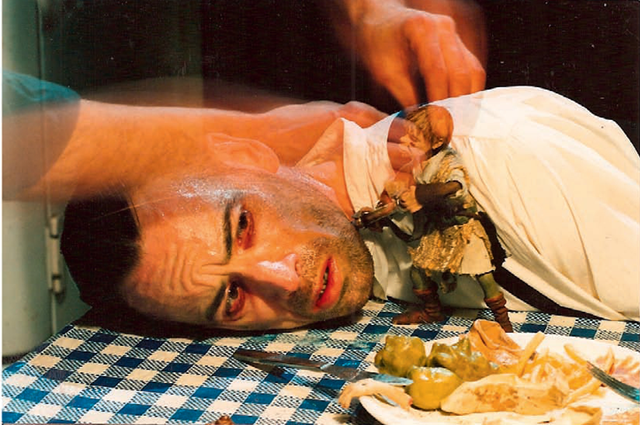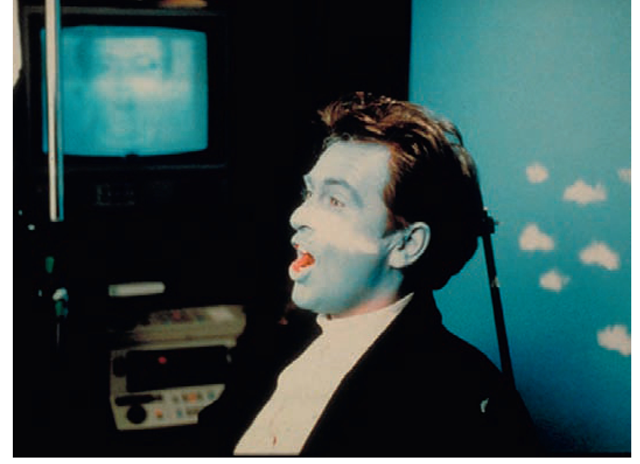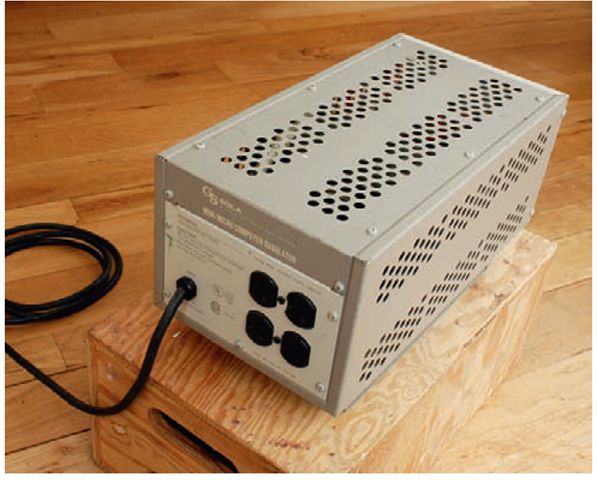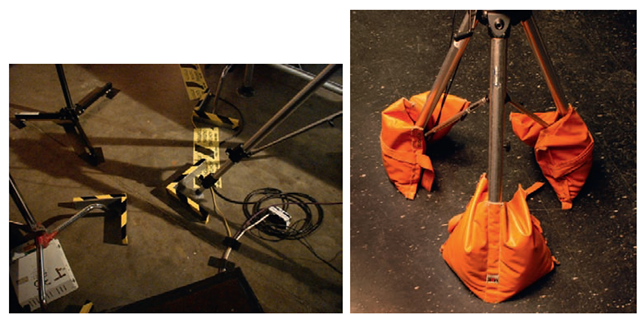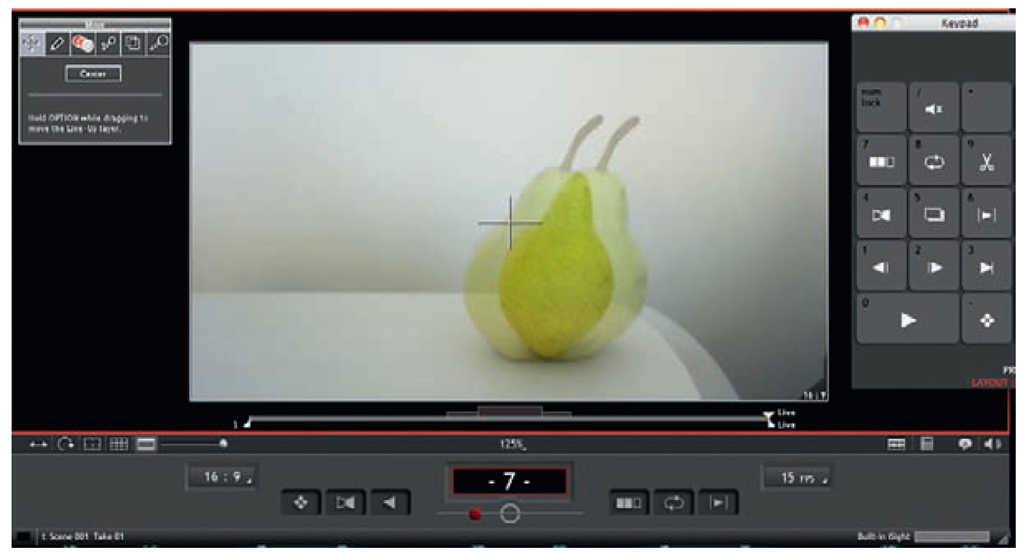People, Objects, and Rigging
Often with pixilation, whether you shoot the subject on a downshooter or horizontally, people and objects are treated in the same way. This can be difficult on the person, especially when everything is treated like an object. It is almost inhumane to animate a human in pixilation for long periods of time with no support or breaks. As Nick Upton, the pixilated star in the 1986 Bolex Brothers film The Secret Adventures of Thumb states:
"Masochists only need apply. It’s not for the fainthearted or weak of spirit.
"In all but the wide (full-figure) shots, make sure there are ‘rock-solid’ supports/guides/reference points, wherever possible, just beyond the edge of the frame, from which you can anchor and thus minimise any unwanted body movement. With regards to breathing, always capture the frame after breathing out, not in, as varying levels of stress, fatigue, or physical exertion can cause irregular intakes of air which can cause a ‘boiling’ of the chest."
Adam Fisher, an independent animator from Maine, animated himself cutting his long beard and hair frame by frame as a metaphor for environmental devastation and overexploitation of natural resources in his 2010 film Timber. He needed assistance and support in the cutting of his hair while he placed himself correctly in front of the camera for registration. This took some careful planning and more careful execution. It took many, many months to grow his hair and beard and any mistakes in the cutting process could have been disastrous in the shooting process. This is his description of the process:
"To shoot Timber, I was seated in front of my computer with Framethief open and a camera pointed at me. Sarah assisted me. I would tell her when to take frames and when to cut hair. I moved as needed, frame by frame, and would get into just the right position. Then I would say something like… ‘okay, trim everything above my finger!’
"We shot the sneeze first, with full beard. This gave us a chance to work out the timing. Once everything else was cut off, we simply repeated the animation without the beard. When I assembled all the frames, I just picked a good spot to switch from no beard to full beard!"
FIG 6.1 a sequence of frames from Adam Fishers’s 2010 film Timber.
Objects and people do need to be treated differently to get the best animated results. In Oren Lavie’s music video Her Morning Elegance, animated by Yuval and Merav Nathan and in the British directorial group Shynola’s "Strawberry Swing" for the band Coldplay, the human subjects were shot lying down on flat surfaces like a bed or a floor. Chris Martin of Coldplay was shot standing and lying down and animated in various positions on the ground with a camera mounted in a stable position high above the ground plane. He still required support but the supports could be hidden behind Martin, out of sight from the camera. In the 1986 groundbreaking Sledgehammer music video, Peter Gabriel was animated with lip movement. He sat upright and was given a head support to steady his head so the focus could be centered on his moving lips.
FIG 6.2 Shot from Peter Gabriel’s Sledgehammer, with a support behind Gabriel’s head.
The main challenge in any stop-motion technique is how to fight gravity. With full body support, like a floor or bed, the human figure can be animated freely in space with no constraints from gravity. This technique is similar to downshooting on a stand but on a grander scale. There are times when people or objects have to be animated with a visible support rig. This can be erased or cleaned out later in postproduction. Any kind of prefabricated or custom rig can be used, as long as it is strong, as small as possible, and relatively lightweight, so it can be maneuvered easily.
FIG 6.3 A series of rigs that can be used for a variety of situations.
Organic and Nonorganic Objects
I would consider humans to be a kind of organic object. Any object that has water as a base, like humans, animals, and plants and anything that is alive, is a challenge for the stop-motion animator. Over a period of time, these organic objects lose their water to evaporation and change in form and color. Here is a very simple experiment that is worth the effort to punch this point home.
Set up a dslr camera, digital video camera, or webcam on a tripod and sandbag or tape it to the floor. Have the camera point down into a close-up of a pack of frozen peas (with the wrapper removed).
Put a 650 watt light about 5 to 6 feet away from the peas and set the time-lapse interval for your camera at a frame every 10 seconds. This may take about 5 to 6 hours but the change is dramatic. You will see the form and color change and that there is no stability in this kind of organic material.
FIG 6.4 Three stages of water-based peas in a time-lapse sequence.
Any object that is manufactured and devoid of fluids is a more dependable and stable object to photograph, allowing you longer shoot times or intervals between frames. The conditions of the environment can really effect the composition of your subject matter. Plasticine can get warm under hot lights and start to shine. Certain organic materials, like water-based paint, can stiffen if the environment is too cold. If you decide that you do want to shoot an organic object frame by frame, then the best approach is to work at a fast, even pace with no extended breaks, so that the changes in the object are small, even, and potentially imperceptible over the running time of the film. On the other hand, using organic materials add another kind of movement and layer to your animation, if that is what you seek.
The choice of objects that you use, whether they are organic or not, is critical to the overall effect of your animation. Objects can signify certain meaning and associations. PES, who has created many wonderful films, makes a point to carefully choose what objects he shoots. Here is his description of his intentional use of certain objects:
"There’s definitely a language of objects involved. I love playing with the layers of association that come with objects, and I strive to tap into these all the time. Examples abound in all my films. Take, for instance, the boiling water in Western Spaghetti: I used bubble wrap to create this effect. It was uncanny how much bubble wrap could be made to look like boiling water. The effect was almost too good—too good because there are people who don’t even notice it’s bubble wrap until the third or fourth viewing, and that means some people will miss the joke. Plus, bubble wrap has bubbles, just like boiling water. They have that very important detail in common, but you’d never imagine one could stand in for the other, no matter how much weed you smoked.
"Another example in Western Spaghetti would be using the Rubik’s cube as garlic. This gag is a totally different approach than bubble wrap because Rubik’s cubes look absolutely nothing like garlic. I forged the connection by focusing on the act of ripping a clove of garlic from the head of garlic. In real life when you do this, you apply pressure with your thumb until crack! The clove comes loose. This action reminded me of when I was a kid and we used to take apart the Rubik’s cubes and reassemble them into completed Rubik’s cubes. This is something many kids remember from the 1980s. You’d apply extreme pressure with a thumb to one of the corner pieces of the cube. It would be pressure, pressure, pressure, then crack!, the piece came off. Your thumb would kill, but it worked. It was then easy to reassemble all the pieces into a completed Rubik’s cube. And, interestingly, that action is exactly how you get a garlic clove off. So, the humor lies in the unexpected connection, the logic I found there."
Shooting Safe Zones
Subject matter is critical for a frame-by-frame film. Where you shoot plays an equally important role. As we discovered, protecting and stabilizing your camera is very important to have control in the overall image. Light, shadows, environmental conditions, and power are all elements that have to be addressed in any stop-motion production. Naturally, if you shoot indoors or in a studio space, you have the option to control these elements. Natural light can be blocked out and simulated through staged lighting, if that is desired. Ideally, there are no erratic weather conditions in the studio, but a few issues do need to be addressed in an indoor shooting environment.
The world is constantly changing. It breaths, expands and contracts. Often, this is too subtle for us to see but time-lapse and extended shoots over time reveal this fact. Humidity affects interior spaces, and this can be a problem only if a shoot goes over an extended period of time. Objects get heated and their molecular structure changes under stage lighting for long periods; and if those lights are turned off for several hours or more, then the cooling and humidifying process can begin. This is influenced by what is going on outside the studio space. If you turn the lights back on and start shooting, you see a shift in the lighting and objects around the shoot. Trying to reduce the temperature and humidity fluctuations with dehumidifiers, air conditioners, and heaters can help stabilize shooting tables, tripods, cameras, flags for lights, reflectors, and objects that are under the camera. This is critical for more detailed and refined stop-motion techniques that require long shoots. Many pixilated films have such dramatic movement and changes in the overall image that they are more forgiving in this area. The changes in exposure and subtle movement of equipment in the scene often cannot be perceived. This reminds me of the practical approach that the Italian graffiti artist Blu uses when he shoots his painted walls around the world. He embraces the wildly fluctuating exposure and intentionally moves his camera frame to frame with slight adjustments so that erratic visual fluttering of the image becomes the norm. This allows Blu to stop and start shooting anytime he wants, because he need not worry about an even, consistent exposure. This approach serves Blu’s work very well, because his painting process takes many days if not weeks to complete, and there is no way that one could maintain any consistency with all these wildly fluctuating environmental conditions (which includes human traffic).
Another piece of equipment that many stop-motion filmmakers utilize is the voltage regulator. This helps keep the electrical input into a studio space even. The normal surges or spikes and drops in power can be avoided through these line conditioners and surge suppressors. Sola and Furman are leading brands in this equipment, but there are several others. This could be an important addition to the stability of a controlled time-lapse event that is shot under controlled conditions in a studio. It is important not to have lights and the exposures fluctuating so the natural change of an object in metamorphosis can be observed.
FIG 6.5 a Sola voltage regulator.
Shooting outdoors presents many unique conditions that must be addressed to make the most of the frame-by-frame approach. It is important to know the effects of these elements so that you can attain the effect that you seek. The single most important element, as mentioned previously, is the sun or lack of it. If you use the sun as your key light, then you must utilize the constant movement of light and shadow that naturally occurs.
A partly cloudy day has the sun disappearing and reappearing, creating large fluctuations in your exposures. If you shoot over a long period of time, like 2 hours or more, then the lighting changes dramatically from the beginning of the shot to the end. There is nothing wrong with these changes, as long as you are aware of them. As we stated, Blu is not concerned about the light changing because he wants the viewer’s focus to be on the dominant drawn figure in the frame. He likes the peripheral movement and distractions, which help focus the eye on the subject. On the other hand, PES shot Roof Sex only on bright, sunny blue-sky days to keep a consistent overall look to all of his exterior shots. In a 2007 Sony Bravia advertisement, called Play-Doh, animation director Darren Walsh directed his animators to move replacement, hopping, model rabbits at exactly every 90 seconds, in Foley Square in New York City. This way the natural shadows, cast by all of the tall buildings surrounding the square, slowly and evenly moved across the frame in an intentional and nondistracting manner. Over 30 animators were equipped with walkie-talkies and given a signal to begin animating with a constant second countdown so they knew when they had to complete their animation and get out of frame to keep that constant 90-second interval shooting pace.
FIG 6.6 This is an example of even shadow movement over parked cars as the result of an even shutter-exposure interval from a dslr camera on park Street in Bristol, United Kingdom.
Another important issue that must be addressed is the stability of the camera. We mentioned this before, but it is critical that no unwanted camera movement occurs. When setting up a camera on a tripod, it is important to lock down all the pan/tilt options that may be available on the tripod head.
Tape the legs to the floor if you are in a studio, or use sand bags to weight down the tripod if there is no even, hard floor. Tripods with mid-leg spreaders offer more stability. It may be convenient to use small pan/tilt heads and lighter tripods, but if you are shooting outside, the wind and other elements, like human traffic, can threaten that critical stability. You may even consider a cable release for shooting your camera if you are not hooked up to a computer controller, so you need not physically come in contact with your camera during a shoot.
FIG 6.7 taped tripod legs and sandbags weighing down the tripod.
This kind of anchoring is necessary for motion-control systems, operated by hand or computer, and all lights that need to remain in place, so shadows and lights do not move in the scene. This is true for all frame-by-frame techniques from pixilation to time-lapse work to shooting on a stand. It certainly is possible to shoot without this kind of lock-down approach, but the chances are that your lights or camera will be blown by the wind, bumped by you or someone on the set, since these are physically demanding techniques, or may slip or move on their own over a period of time. After all, it is a wobbly breathing world and nothing is truly static. An accidental bump can be cause for a total reshoot. Although I advocate a controlled and stable shooting space, it is important to note that some of these techniques are being used in a much more uncontrolled manner these days, and that is the intention of the filmmakers. This adds a fresh look to the animation and certainly is very "postmodern" in approach. It is difficult to save a shot with an accidental camera bump in mid-shot. One approach to rectifying a bump in the camera is using a frame-grabber program that has an "onionskin" capability. If the camera moved, then you can try to coax the camera carefully back into place. This may work if your subject is active. It is much more difficult if the image has been static. Naturally, planning a cutaway and other filmic solutions can save a reshoot but you compromised your original intent because you did not take the time to lock everything down.
FIG 6.8 A screen grab of two frames being ghosted or onionskinned one on top of the other for camera and object placement registration.
The next area that we cover all takes place in an interior or studio space. Downshooting, which still requires a camera, takes place on an animation stand housed in a studio with stage lighting. This area of frame-by-frame shooting has a wide range of approaches and materials. Let us examine some of these approaches.
